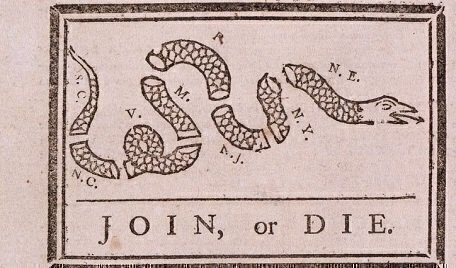On this day in 1754, Benjamin Franklin published one of the most famous cartoons in history: the Join or Die woodcut. Franklin’s art carried significant importance at the time and is considered an early masterpiece of political messaging.

At the time, Franklin was the publisher of the Pennsylvania Gazette. He also had been chosen as a delegate for an upcoming conference in Albany, New York, to deal with a combined threat to the British from French and Indian forces.
During what later became known as the Albany Congress, representatives from seven colonies – Connecticut, Maryland, Massachusetts, New York, New Hampshire, Pennsylvania and Rhode Island – were going to meet to discuss the French threat and work on a treaty with the Iroquois Confederacy.
As the Albany Congress approached, Franklin was concerned about a recent military loss to the French and he was clearly pondering a colonial alliance to confront more French aggression. A few days after the small military defeat, Franklin published an article about the loss, as reported by a young major in the Virginia Regiment, George Washington.
“The Confidence of the French in this Undertaking seems well-grounded on the present disunited State of the British Colonies, and the extreme Difficulty of bringing so many different Governments and Assemblies to agree in any speedy and effectual Measures for our common Defence and Security,” Franklin wrote.
“They presume that they may with Impunity violate the most solemn Treaties subsisting between the two Crowns, kill, seize and imprison our Traders, and confiscate their Effects at Pleasure (as they have done for several Years past) murder and scalp our Farmers, with their Wives and Children, and take an easy Possession of such Parts of the British Territory as they find most convenient for them,” Franklin concluded, warning that the British presence in North America was at stake.
Accompanying the article was the “JOIN, OR DIE” cartoon, with a snake cut into eight pieces that symbolized the British colonies. Franklin’s message hit home as the cartoon and article started appearing in other colonial newspapers.
In a 1996 article in The British Library Journal, Karen Severud Cook reviewed the brief, but interesting, historical interpretations of the cartoon. Franklin’s cartoon, Cook said, was also a symbolic map, with the initials next to the snake’s segments in the same order of the colonies and a rough proximity of a coastline.
It is likely that Franklin himself didn’t engrave the etching, since he was busy with his political career. The “Join or Die” cartoon also wasn’t the first political cartoon he had published; Franklin had done another cartoon for a pamphlet in 1747.
A severed snake image, in two pieces, had first appeared in a 1685 book in France accompanied by the words “se rejoindre ou mourir” (will join or die). And Franklin might also have been inspired by rattlesnake images drawn by nature historian Mark Catesby.
The emblematic image gained considerable attention as the Albany Congress approached. The Congress met in June and July, where Franklin proposed an early version of a unified colonial government. A President General appointed by the crown and a Grand Council of representatives would be appointed by each of the colonies. Franklin’s government was limited in scope: It could provide for joint military protection and also levy taxes. The Congress approved the plan, but the British government and the colonies never acted on it.
In later years, the Join or Die cartoon resurfaced on important occasions. The emblem reappeared in colonial newspapers during the Stamp Act crisis. Versions of the snake cartoon appeared in newspapers during the American Revolutionary War, sometimes as part of a masthead. And the snake cartoon was used by both sides during the Civil War.







